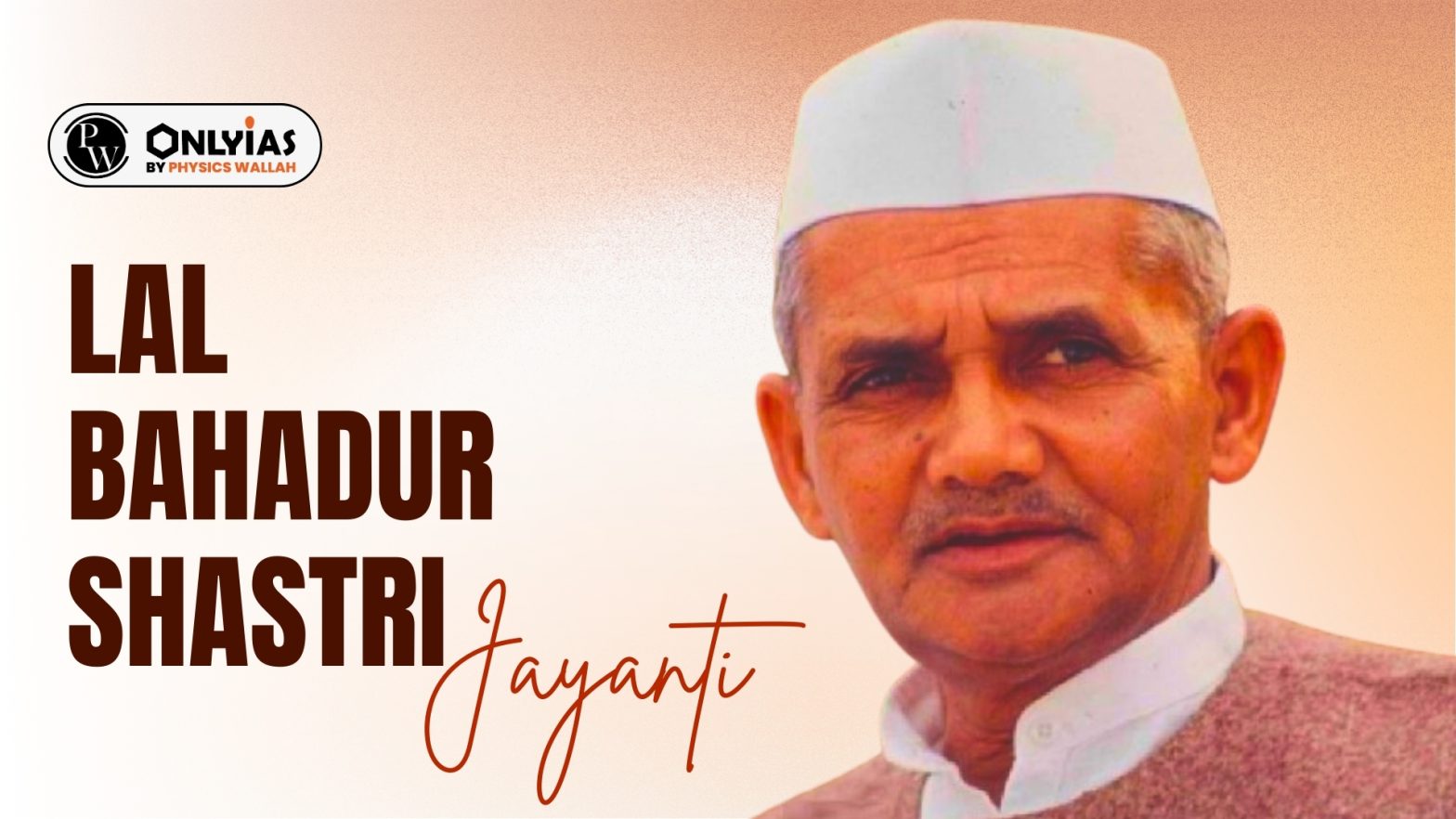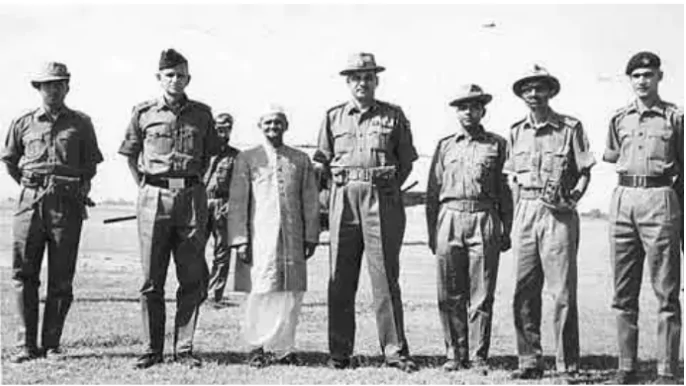
Lal Bahadur Shastri Jayanti: Lal Bahadur Shastri was one of India’s most respected leaders and was known for his humbleness, integrity, and strong leadership during a crucial period in Indian history. Every year, on Lal Bahadur Shastri Jayanti, the nation pays tribute to the second Prime Minister of India, while celebrating his life and contributions to the country. This special day is a time to reflect on the values Shastri illustrated and the unforgettable impact he left on India’s socio-political landscape.
Every year Lal Bahadur Shastri Jayanti is celebrated on October 2nd, to honour the birth anniversary of Lal Bahadur Shastri, who was the second Prime Minister of India. He was born on October 2, 1904, in Mughalsarai, Uttar Pradesh, Shastri is often remembered for his simplicity, humility, and leadership during critical periods of India’s history, particularly the Indo-Pak War of 1965.
The iconic slogan given by him “Jai Jawan Jai Kisan” focuses on the importance of the armed forces and farmers, reflecting his vision for a strong, self-reliant nation. Shastri played a vital role in advancing India’s agricultural and defence sectors, laying the groundwork for the Green Revolution and the White Revolution.
Lal Bahadur Shastri Jayanti 2024 is a day to celebrate his legacy, life, and contributions to India’s progress and unity. Factors like simplicity and uncompromising integrity characterised Shastri’s life. Even as Prime Minister, he lived a humble life and never seek for personal gain or luxuries. He was known for his humility, fairness, and ability to connect with ordinary citizens.
Lal Bahadur Shastri was born into a modest family, and he grew up with limited resources but had a strong sense of patriotism. His father, Sharada Prasad Srivastava, was a school teacher, and his mother, Ramdulari Devi, was a housewife. He lost his father at a young age, despite this he indulged himself in his studies and was deeply influenced by Mahatma Gandhi’s ideology of non-violence and simplicity. Due to the caste system, he dropped his surname, Srivastava, as a sign of denial of the caste system, instead he choose the honorific “Shastri” after completing his degree in philosophy at Kashi Vidyapeeth.
Lal Bahadur Shastri Biography Table |
|
| Aspect | Details |
| Full Name | Lal Bahadur Shastri |
| Date of Birth | October 2, 1904 |
| Place of Birth | Mughalsarai, Uttar Pradesh, India |
| Parents | Sharada Prasad Srivastava (father), Ramdulari Devi (mother) |
| Education | Kashi Vidyapeeth (Degree in Philosophy, “Shastri” title) |
| Political Party | Indian National Congress |
| Positions Held | 2nd Prime Minister of India (1964-1966) |
| Key Contributions | “Jai Jawan Jai Kisan” slogan, White Revolution, Green Revolution |
| Notable Events | Indo-Pak War of 1965, Tashkent Agreement |
| Spouse | Lalita Devi |
| Children | 6, including Anil Shastri and Sunil Shastri |
| Date of Death | January 11, 1966 (Tashkent, Uzbekistan) |
| Cause of Death | Heart attack (under mysterious circumstances) |
Lal Bahadur Shastri Jayanti is celebrated on October 2nd, the same day as Mahatma Gandhi’s birth anniversary. Born on October 2, 1904, in Mughalsarai, Uttar Pradesh, Shastri shared his birth date with the Father of the Nation, making this day doubly significant in India’s calendar. The nation observes Lal Bahadur Shastri’s birth anniversary to honour the life of a leader who dedicated himself to the service of India.
In 2024, India will celebrate the 120th Birth Anniversary of Shri Lal Bahadur Shastri, commemorating the legacy of a leader who continues to inspire generations. On this special occasion, various events, speeches, and cultural programs are organized across the country to remember his life, his principles, and the invaluable service he rendered to India.
Lal Bahadur Shastri’s completed his schooling in Mughalsarai and later pursued higher education at the Kashi Vidyapeeth in Varanasi. His dedication to academics and his interest in social and political issues began to appear during his university years.
Despite financial limitations, Shastri continued his education and went on to complete a degree at the University of Allahabad. The academic environment exposed him to the ideas of the Indian independence movement, and he became actively involved in the struggle against British rule.
Shastri’s entry into politics was characterised by his association with the Indian National Congress and his commitment to Mahatma Gandhi’s principles of non-violence and civil disobedience. His involvement in various protests and movements against British rule showcased his commitment to the cause of India’s independence.
Lal Bahadur Shastri’s early political career evolved through the Indian National Movement, where he appeared as a dedicated and disciplined leader. Shastri made significant contributions to the Indian National Movement, actively participating in key campaigns like the Non-Cooperation Movement and the Salt Satyagraha. He was imprisoned multiple times for his involvement in civil disobedience against British rule. His dedication to Mahatma Gandhi’s principles of non-violence and his role in organizing protests and mobilizing people for India’s independence made him a committed freedom fighter.
In the post-independence era, Shastri’s political career sought skies as he accepted the role of Parliamentary Secretary in Uttar Pradesh. His ministerial positions included Minister of Police and Transport, Railways Minister, Minister of Commerce and Industry, and Minister of Home Affairs.
The untimely demise of Jawaharlal Nehru in 1964 catapulted Shastri into the position of Prime Minister. Lal Bahadur Shastri succeeded Jawaharlal Nehru and became the 2nd Prime Minister of India on June 9, 1964. Though his tenure was relatively short, from 1964 to 1966, Shastri made remarkable contributions that fixed his place in history as a leader who led the country with great courage and wisdom.
Shastri’s leadership faced the challenging Madras anti-Hindi agitation of 1965. Responding to the resistance against establishing Hindi as the sole national language, he assured the continued use of English, defusing tension.
Continuing Nehru’s socialist economic policies, Shastri championed the White Revolution, supporting the Amul co-operative to increase milk production. His initiation of the Green Revolution in 1965 aimed at enhancing food grain production, particularly in Punjab, Haryana, and Uttar Pradesh.
One of Lal Bahadur Shastri’s greatest achievements was giving the famous slogan “Jai Jawan Jai Kisan”, meaning “Hail the Soldier, Hail the Farmer.” This phrase highlights the vision of Shastri ji for a strong, self-reliant India, emphasizing the importance of soldiers defending the nation and farmers feeding it.
Shastri’s leadership came at a critical time when India was facing an extreme food shortage and external threats, particularly from Pakistan. His call for unity and resilience through “Jai Jawan Jai Kisan” not only boosted national morale but also led to significant advancements in both agriculture and defence which had shaped India’s revolution for years to come.
Lal Bahadur Shastri followed Nehru’s non-alignment policy while strengthening the relations with the Soviet Union. In response to the Sino-Indian War of 1962 and the growing military alliance between China and Pakistan, Shastri’s government took a proactive standpoint by expanding the defence budget in 1964.

Lal Bahadur Shastri strengthened India’s relations with the Soviet Union by recognizing it as a key ally during his tenure. The USSR played a crucial role in maintaining peace between India and Pakistan after the Indo-Pak War of 1965, leading to the Tashkent Agreement. Shastri’s diplomatic efforts ensured strong bilateral relations, with the Soviet Union providing economic and military support, which further solidified India’s strategic position during the Cold War.
The Indo-Ceylon Agreement, also known as the Bhandarnaike-Shastri Pact, was a pact inked by the prime ministers of the two nations in 1964. This agreement significantly influenced the status and future of individuals born in India who were residing in Ceylon (later Sri Lanka), particularly those who were the descendants of tea estate laborers transported by the British.
Regarding Burma, weakened relations appeared after the military takeover in 1962, leading to the displacement of many Indian families in 1964. To address this situation, Shastriji undertook an official visit to Rangoon in 1965, successfully restoring friendly relations between the two countries.
Amidst border tensions and fights in the Kutch region in 1965, Shastri presented a dedicated commitment to economic development over military conflicts. He affirmed India’s dedication to peaceful coexistence but made it clear that the nation would not compromise its freedom.
The major conflict was noticed on August 1, 1965, marked by attacks from militants and Pakistani soldiers. India responded by crossing the Ceasefire Line and even the International Border near Lahore. Intense battles occurred, including tank warfare in Punjab and strategic captures in Kashmir.
The Indo-Pak war concluded on September 23, 1965, following a United Nations-mandated ceasefire. In his national broadcast on the ceasefire day, Shastri highlighted the importance of ending not just the armed conflict but also the deeper issues through peaceful coexistence.
During his tenure as Prime Minister, Lal Bahadur Shastri made many decisions that showcased his leadership capabilities. Some of his most notable achievements include:
Shastri’s unwavering leadership was most evident during the Indo-Pak War of 1965. Under his guidance, India successfully defended its borders, and his diplomatic skills came to the forefront during the Tashkent Agreement negotiations. Although he signed the peace agreement with Pakistan, Shastri passed away in Tashkent under mysterious circumstances, leaving a legacy of determination and national pride.
During the Indo-Pak War of 1965, Shastri ensured that India’s armed forces were well-equipped and prepared to defend the nation. His leadership encouraged a sense of unity and purpose among the military, and his decision to give a free hand to the army resulted in a decisive defense of Indian territory.
Shastri played a key role in the White Revolution, a campaign to increase milk production in India, which significantly improved the country’s agricultural economy. He supported Dr. Verghese Kurien, the founder of the White Revolution, and worked towards the establishment of the National Dairy Development Board.
Recognizing the importance of agriculture, Shastri promoted policies that laid the foundation for the Green Revolution in India. He encouraged the use of high-yield variety seeds, fertilizers, and modern agricultural techniques, which significantly increased food production and helped India to become self-sufficient in food grains.
Lal Bahadur Shastri’s sudden demise in Tashkent on January 11, 1966, one day after signing the peace treaty, left behind a legacy of leadership during a crisis. The circumstances surrounding his death have provoked many conspiracy theories, with claims of foul play. His contributions to India’s progress, associated with his ethical governance, continue to shape the nation’s narrative. Memorials, institutions, and roads named after him stand as examples of the enduring legacy of Lal Bahadur Shastri.
Lal Bahadur Shastri Jayanti acts as a reminder of the life and contributions of one of India’s most respected leaders. His leadership during challenging times, his focus on self-reliance, and his unwavering dedication to the nation have made him a symbol of integrity and patriotism.
As we celebrate the 120th Birth Anniversary of Shri Lal Bahadur Shastri, it is important to remember his legacy and the values he stood for. His famous slogan “Jai Jawan Jai Kisan” continues to resonate with India’s aspirations for progress and self-sufficiency. On this Lal Bahadur Shastri Jayanti, let us honour his memory by embracing the principles of unity, simplicity, and national service that he so dearly cherished.
Sign up for the PWOnlyIAS Online Course by Physics Wallah and start your journey to IAS success today!
| Other Famous Personalities Biographies | |
| Subhash Chandra Bose | Jyotiba Phule |
| Mahatma Gandhi | Raja Ram Mohan Roy |
| Satyendra Nath Bose | Jawaharlal Nehru |
<div class="new-fform">
</div>
